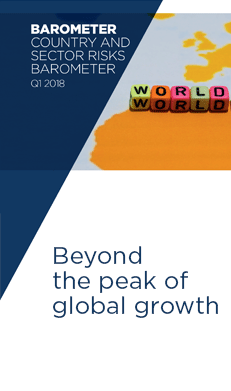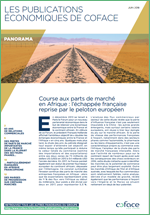France’s loss of market share in Africa benefits several European countries, China and India

In 2017, Germany overtook France to become Europe’s leading supplier to the African continent. While France’s trade balance has remained in surplus (apart from in 2008 and 2012, when oil prices reached all-time highs), its market share of exports to Africa halved from 11% in 2000, to 5.5% in 2017. This loss concerns all key export sectors, with the exception of aerospace. Nevertheless, according to the recent analysis conducted by Coface, there are 27 African countries that could represent a potential rise of around 21% in exports.
The slump concerns capital goods, the automotive sector and pharmaceuticals
The erosion of France’s share of exports to Africa is part of the more widespread deceleration of French exports globally (which fell from 4.7% in 2001, to 3% in 2017). To a lesser extent, Italy, the UK and the US are following a similar trend in terms of exports to the African continent. Unsurprisingly, China has seen a rapid increase in its market share (from 3% in 2001, to around 18% in 2017), followed by India, Turkey and Spain.
The weight of French sales to Africa is falling in all key sectors, with the notable exception of theaerospace sector,which is continuing to post good performance (market share rose to 33% in 2017, up from 12% in 2001).
- In the machinery sector, France’s portion of exports to Africa halved between 2001 and 2017 (down from 12% to 6%). As with Italy and Germany, this was due to competition from Turkey, Spain and in particular China, whose share increased eightfold, to reach a quarter of all machinery exports to the African continent. In several of the French-speaking African countries, the fall in France’s market share is striking and has dropped by between 15 to 20 percentage points (pp) in Algeria, Morocco, the Ivory Coast and Cameroon and by 25 pp in Senegal.
- In the electrical and electronic appliance sector, France, the leader until 2006, saw its market share fall to 3% in 2017 (vs 16% in 2001). China’s share followed the opposite trajectory, rising from 7%, to reach more than a third of exports to the African continent. France’s market share in French-speaking Africa has fallen by 20 pp.
- France’s portion of the export market in thepharmaceutical sectoralmost halved during the same period (down from 33% in 2001, to 19% in 2017). At the same time, India’s share of pharmaceutical exports to Africa rose from 5% to 18%, driven by the low-cost generic drugs segment. Belgium, Switzerland, Germany and the UK have also gained from France’s export decline to French-speaking Africa.
- In the automotive sector, competition from China and India (now Africa’s fourth largest supplier in this segment) was particularly marked. France’s drop from third position in 2001, to seventh place in 2017 (down from 15% to 5%) was exacerbated by the progress of other European countries, such as Romania and Spain, particularly with exports to the Maghreb.
- The decline in France’s market share insales of wheat(11% in 2017, vs 16% in 2001) was partly due to an extremely poor harvest, but above all to competition from Romania, Ukraine and Russia. Together, these three countries supplied more than 40% of total wheat exports to Africa in 2017 (compared with only 3% in 2001). Meanwhile, Canada, the US and Argentina made strong progress in Algeria and Senegal.
A potential gain of 21% for exports to 27 countries
Coface’s analysis indicates that there is a potential gain for French exports to Africa (in value terms) of around 21%, which would allow it to regain a market share equivalent to the pre-crisis levels of 7%. This is mainly linked to the fact that French export levels are below potential in 27 of the 53 countries analysed, and specifically in:
- the countries where France’s presence is relatively stable, such as East Africa (10% below potential) and, to a lesser extent, in Southern Africa, where the gap between trade conducted and potential trade varies from -2% for Uganda, to -71% for Botswana and -89% for Rwanda. In certain countries such as Somalia (-25%), Zimbabwe (-40%) and Sudan (-71%), corporate behaviour has been affected by political risks;
- the countries geographically closest to France, such as Morocco (-29%) and Algeria (-53%), which are already among France’s leading trade partners;
- the countries with a legal system of French origin, including some of the markets in French-speaking Africa (-26%), particularly in the Sahel (Mali, Burkina Faso, Niger and Chad).
In certain African economies that share neither the same language, nor the same legal system, French exports exceed the levels estimated by Coface’s model. This is the case for South Africa, Namibia, Ghana, Angola, Kenya and Nigeria. These results suggest that factors other than those included in the model are having a positive impact on French exports to these countries.
DOwnload the publication:





